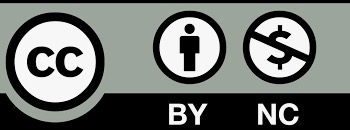Published
2022-06-20
Issue
Section
Research Articles
License
The journal adopts the Attribution-NonCommercial 4.0 International (CC BY-NC 4.0), which means that anyone can reuse and redistribute the materials for non-commercial purposes as long as you follow the license terms and the original source is properly cited.
Author(s) shall retain the copyright of their work and grant the Journal/Publisher rights for the first publication with the work concurrently licensed since 2023 Vol.8 No.2.
Under this license, author(s) will allow third parties to download, reuse, reprint, modify, distribute and/or copy the content under the condition that the authors are given credit. No permission is required from the authors or the publisher.
This broad license intends to facilitate free access, as well as the unrestricted use of original works of all types. This ensures that the published work is freely and openly available in perpetuity.
By providing open access, the following benefits are brought about:
- Higher Visibility, Availability and Citations-free and unlimited accessibility of the publication over the internet without any restrictions increases citation of the article.
- Ease of search-publications are easily searchable in search engines and indexing databases.
- Rapid Publication – accepted papers are immediately published online.
- Available for free download immediately after publication at https://esp.as-pub.com/index.php/ESP

Copyright Statement
1.The authors certify that the submitted manuscripts are original works, do not infringe the rights of others, are free from academic misconduct and confidentiality issues, and that there are no disputes over the authorship scheme of the collaborative articles. In case of infringement, academic misconduct and confidentiality issues, as well as disputes over the authorship scheme, all responsibilities will be borne by the authors.
2. The author agrees to grant the Editorial Office of Environment and Social Psychology a licence to use the reproduction right, distribution right, information network dissemination right, performance right, translation right, and compilation right of the submitted manuscript, including the work as a whole, as well as the diagrams, tables, abstracts, and any other parts that can be extracted from the work and used in accordance with the characteristics of the journal. The Editorial Board of Environment and Social Psychology has the right to use and sub-licence the above mentioned works for wide dissemination in print, electronic and online versions, and, in accordance with the characteristics of the periodical, for the period of legal protection of the property right of the copyright in the work, and for the territorial scope of the work throughout the world.
3. The authors are entitled to the copyright of their works under the relevant laws of Singapore, provided that they do not exercise their rights in a manner prejudicial to the interests of the Journal.
About Licence
Environment and Social Psychology is an open access journal and all published work is available under the Creative Commons Licence, Authors shall retain copyright of their work and grant the journal/publisher the right of first publication, and their work shall be licensed under the Attribution-NonCommercial 4.0 International (CC BY-NC 4.0).
Under this licence, the author grants permission to third parties to download, reuse, reprint, modify, distribute and/or copy the content with attribution to the author. No permission from the author or publisher is required.
This broad licence is intended to facilitate free access to and unrestricted use of original works of all kinds. This ensures that published works remain free and accessible in perpetuity. Submitted manuscripts, once accepted, are immediately available to the public and permanently accessible free of charge on the journal’s official website (https://esp.as-pub.com/index.php/ESP). Allowing users to read, download, copy, print, search for or link to the full text of the article, or use it for other legal purposes. However, the use of the work must retain the author's signature, be limited to non-commercial purposes, and not be interpretative.
Click to download <Agreement on the Licence for the Use of Copyright on Environmental and Social Psychology>.
How to Cite
Inmate Perceptions: The Impact of a Prison Animal Training Program Background
Debra Mims
Criminal Justice, Social Work Saint Leo University, Saint Leo, Florida United States Jessie Holton, 700 Park Avenue, Titusville, Florida 32780, United States
Rhondda Waddell
Criminal Justice, Social Work Saint Leo University, Saint Leo, Florida United States Jessie Holton, 700 Park Avenue, Titusville, Florida 32780, United States
Jessie Holton
Criminal Justice, Social Work Saint Leo University, Saint Leo, Florida United States Jessie Holton, 700 Park Avenue, Titusville, Florida 32780, United States
DOI: https://doi.org/10.18063/esp.v7.i1.753
Keywords: Animal assisted therapy, Service animals, Prison animal training
Abstract
The purpose of this qualitative study was to explore the perceptions of jail inmates participating in the Paws and Stripes College program. The Paws and Stripes College program involves incarcerated inmates training local humane shelter canines’ obedience training techniques using the canine good citizen model as well as teaching the canines skills in which to participate as comfort/emotional support dogs. Using secondary data from self-report questionnaires completed by the inmates, this study sought to explore how the inmates felt before and after their exposure to the Paws and Stripes College program. Specifically, if the inmates felt that participation in the program was beneficial to them or not, and if so, how.
Author Biography
Debra Mims, Criminal Justice, Social Work Saint Leo University, Saint Leo, Florida United States Jessie Holton, 700 Park Avenue, Titusville, Florida 32780, United States
Dr. Mims is an Assistant Professor of Education with the School of Education and Social Sciences and teaches in the Department of Criminal Justice. She has been a member of the Saint Leo Community since 2011.Dr. Mims received her doctoral degree in Business Administration with a concentration in Criminal Justice from Northcentral University. Dr. Mims has taught at the Pasco-Hernando State College Police Academy and the Hillsborough Community College Police Academy. Dr. Mims is a retired Tampa Police officer where she served on the Mounted Patrol Unit, Bicycle Unit, worked as an Undercover and Community Service Officer. She was also a child abuse, elderly abuse and domestic violence investigator. Dr. Mims is a certified firearms instructor as well as a CPR/BLS instructor.
Dr. Mims teaches a variety of criminal justice courses within the Department of Criminal Justice. Her research passion is the animal/human bond and animal-assisted interventions that contribute to the health and well-being in the lives of individuals, both young and old.
References
[1]. Bustad, LK. Prison Programs Involving Animals. In: Bustad L editor. Compassion, our Last Great Hope. Renton, WA: Delta Society; 1990. p. 72-73.
[2]. Britton D, Button, A. This isn’t about us. Benefits of Dog Training Programs in Women’s Prisons. In: Miller S, editor. Criminal Justice and Diversity: Voices from the Field. U. Lebanon, NH: U. Press of England; 2007. p. 195-208.
[3]. Zaidlicz R. A Prison Horse Program. Orlando, FL: Delta Society Annual Conference; 1988.
[4]. Patten M. Questionnaire Research a Practical Guide. New York: Taylor and Francis Group; 2014. p. 169.
[5]. Kielhofner G. Research in Occupational Therapy. Philadelphia, PA: FA Davis; 2006.
[6]. Ensminger J. Service and Therapy Dogs in American Society; Science, Law and the Evolution of Canine Caregivers. Charles Thomas: Springfield, IL; 2010.
[7]. Deaton C. Humanizing Prisons with Animals a Closer Look at “Cell Dogs” and Horse Programs in Correctional Institutions. The Journal of Correctional Education 2005;56(1):46-62.
[8]. Currie N. Inmates Learning: Case Study of Incarcerated Males Participating in a Canine Training Program. Manhattan, Kansas: Kanas State University; 2000. p. A2.







